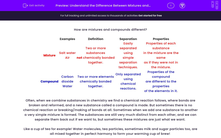How are mixtures and compounds different?
| Examples | Definition | Separation | Properties | |
| Mixture |
Salt water Air |
Two or more substances not chemically bonded together. |
Easily separated using simple separation techniques. |
Properties of each substance in the mixture are the same as if they were not in the mixture. |
| Compound |
Carbon dioxide Water |
Two or more elements chemically bonded together. |
Only separated using chemical reactions. |
Properties of the compound are different to the properties of the elements in it. |
Often, when we combine substances in chemistry we find a chemical reaction follows, where bonds are broken and reformed, and a new substance called a compound is made. But sometimes there is no chemical reaction or breaking/making of bonds at all. Sometimes when we add one substance to another a very simple mixture is formed. The substances are still very much distinct from each other, and we can separate them back out if we want to, but sometimes these mixtures are just what we want.
Like a cup of tea for example! Water molecules, tea particles, sometimes milk and sugar particles too, are all mixed together in perfect harmony to form your warming cup of brew!

As you can imagine, not everyone makes their tea the same way. And that's ok. It's still a mixture - a mixture is unique in that the proportion of each component is variable in it, unlike a compound where there is a specific ratio of each element in the final compound.
A solution is a type of mixture where one of the substances dissolves in the other. The substance that dissolves (usually a solid or powder) is called the solute. The substance that allows the solute to dissolve in it (a liquid) is called the solvent.
There will be many examples of mixtures you have come across before. But did you know that blood is a mixture? It contains different types of blood cells and plasma and each can be easily separated by doctors if required. Crude oil is also a mixture - we can use fractional distillation to separate the different hydrocarbons in crude oil to make useful products. Ink is also a mixture, made from different coloured dyes - we can separate these out using a technique called chromatography. We shall cover the techniques used to separate mixtures in another activity, but for now, shall we try some questions on mixtures?

Let's go!








